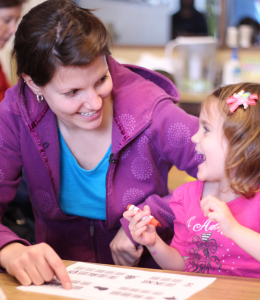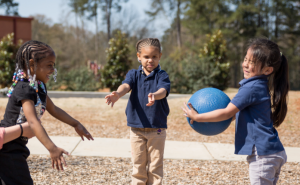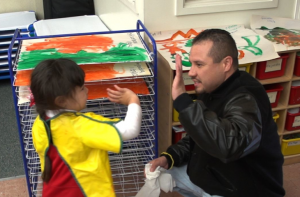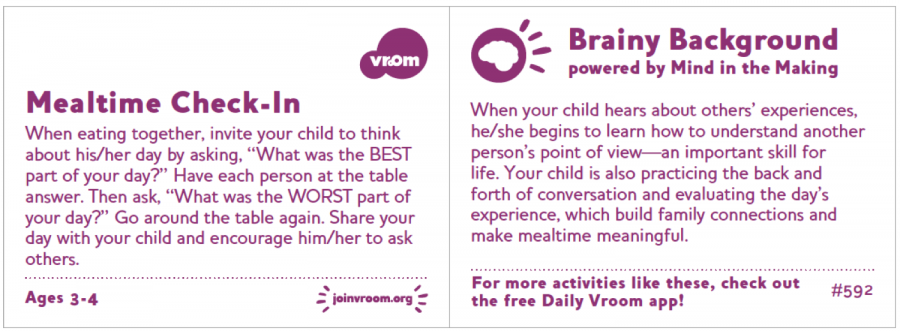7-2 Social and Emotional Development and School Readiness
A – School Readiness
7 Essential Skills
The seminal publication Heart Start: The Emotional Foundations of School Readiness, by the organization Zero To Three, identifies seven essential school readiness skills:
- Confidence
- Curiosity
- Intentionality
- Self-control
- Relatedness (being able to engage with others based on a sense of understanding)
- Capacity to communicate
- Cooperativeness
These skills fall under the umbrella of five developmental areas:
- Self-control
- Self-confidence
- Thinking skills
- Language and literacy
- Relationship-building
At least two of those areas fall within the domain of Social and Emotional Development. The related skills that we’ve covered in this session so far are: confidence, self-control, relatedness, communication (not just language, also social cues), and cooperativeness.
School readiness begins at birth with the relationships that infants establish with adults. Those relationships are echoed in children’s relationships and social strategies with other children. These relationships help children to learn about themselves and gain both self-control and self-confidence as they learn more and more social skills.
Video: School Readiness (4:30)
This video School Readiness covers the key characteristics of school readiness and how adult and peer relationships are connected to children’s school readiness.
While watching the video, think about:
- Key skills that children need for school readiness.
- What parents and educators can do to encourage school readiness skills.
Watch School Readiness from ZEROTOTHREE on Vimeo.

Video Debrief
What did you hear about key readiness skills? (click to toggle expand or collapse)
Possible Answers
You may have heard that key readiness skills are:
- Language and literacy skills
- Thinking skills
- Social and emotional development
To encourage children to develop these skills, parents and educators can:
- Share books and stories with children.
- Sing with children.
- Have back-and-forth conversations.
- Narrate what they are doing.
- Teach vocabulary.
- Count objects.
- Model self-regulation.
- Point out skills.
- Encourage children to persist.

Reflection Point
Think about three areas you think are important for school readiness. You may identify any of the three characteristics identified in the last video—language and literacy skills, thinking skills, or social and emotional development–or other ideas based on personal experiences.
What are the reasons for your choices and experiences you’ve had encouraging children to develop skills in these areas?
B – Developing Skills
Relationships with Adults

Children develop models of how they expect to be treated and how to treat others through their early childhood interactions with educators and parents. These relationship models can affect their future relationships with educators and other adults in formal school settings.
Children’s relationships with adults are key to school readiness. Through positive and trusting relationships with adults, children learn many critical social and emotional skills, such as:
- Self-control: Learn to follow rules and social norms from watching and engaging with adults.
- Language and literacy: Learn language and literacy from engaged adults.
- Thinking Skills: Learn how to solve problems from scaffolding and modeling by adults.
From birth, children are learning how people will treat them and how they should treat others initially through their interactions with caregiving adults. These relationships form models from which children build their own future relationships.
If caregiving adults are compassionate, caring, and attentive, children will learn to expect to be treated with care, compassion, and attention, and also to treat others in the same way.
Relationships with Other Children

As children mature, their relationships with other children will play a larger role in their educational success. Children who are accepted by their social group feel supported and confident. Those who do not may suffer from depression and other mental health issues that will also adversely affect their ability to learn.
Learning how to solve social problems with their peers also teaches children valuable thinking skills. Social problem-solving can easily be viewed through the same lens as cognitive problem-solving. Social problem-solving requires the same:
- Observational skills (the need to identify that a social problem is occurring by noting another person’s emotional state as well as one’s own emotional state).
- Questioning, theory-building, and predicting of others’ emotional states.
- Exploration or reflection on the effectiveness of one’s social strategies or actions.
Therefore social problem-solving is associated with similar thinking skills as cognitive problem-solving. Moreover, children who have more prosocial skills tend to be better accepted by their peers and to have lower levels of stress. All of these aspects will help them learn more and retain information longer than children lacking those skills.
Recent studies have confirmed this association between social skill development and cognitive development. For example, a recent study of Head Start children showed that those who scored higher on assessments of prosocial competence were, later on in the year, assessed to be among the most cognitively ready for school.
C – Emotional Functioning
Understanding others’ perspectives and being able to regulate one’s own responses are key factors in building relationships with both adults and other children.
Eye gaze is one important way that children do this. Through the development of eye gaze understanding, children build the skills to observe other people’s desires or intentions. For example, even if someone doesn’t say they want your ball, if they look sad and keep staring at the ball you’re holding, it’s very likely that what they are sad about is not having the ball to play with.
This then helps children begin to recognize how to engage in prosocial activity, such as sharing the ball with the sad child or finding another ball for the child to play with.
The development of theory of mind takes this a step further by giving children the ability to form theories about the social world. For example, maybe you give the sad child the ball, but that doesn’t make them happy. You think, maybe the child wanted to play with me with the ball? Maybe I should kick the ball to the sad child instead.
Without a theory of mind, it is difficult to construct theories as to why another person is responding socially in different ways and to then determine prosocial actions that correspond to their emotional state.
And of course, emotion regulation and emotional literacy are key to these abilities as well. Without emotion regulation, children can be overwhelmed by their own emotions to a degree that hinders them from thinking through social problems to come up with solutions.
Emotional literacy helps children with emotion regulation by identifying their own emotions and picking target strategies to regulate those emotions. Emotional literacy also helps with social problem-solving by, for instance, identifying that the other child is sad, rather than mad, frustrated, or any other negative valence emotion.
Putting these all together, children who develop the skills within the subdomain of Emotional Functioning by the time they enter school have a catalogue of tools to navigate the complex social world of a formal school environment, such as new class rules and routines, different social groups (and typically, larger class sizes), and new teachers and administrators.
Sense of Identity and Belonging

Self-confidence is yet another important factor in school readiness.
Children who are more self-confident also are more likely to take on challenges, overcome frustrations, and act pro-socially toward others.
This is a very active area of developmental research. One of the leading researchers on the intersection of self-confidence and children’s school readiness is Dr. Carol Dweck at Stanford University.
Dr. Dweck pioneered research on how different styles of praise can affect children’s learning perspectives and their likelihood of academic success.
Video: The Growth Mindset(11:42)
Next, watch a video of Dr. Dweck’s presentation The Growth Mindset at the Stanford University Bing Nursery Research Symposium in 2016.
Another option would be to watch Dr. Dweck’s talk on TED instead. It covers similar content. The Power of Believing You Can Improve is available here: The power of believing that you can improve | Carol Dweck.
While viewing the video, consider the answers to these questions:
- What is the difference between a growth mindset and a fixed mindset?
- When do children begin to be affected by their mindset?
- What three things does Dr. Dweck say we can do to change a child’s mindset?
Watch The Growth Mindset from Bing Nursery School, Standford on YouTube.

Video Debrief
What is the difference between a growth mindset and a fixed mindset?(click
to toggle expand or collapse)
Possible Answer
- A growth mindset is the belief that talents and abilities can grow through hard
work and practice, for example, thinking that you need to practice math more to
get better at it. A fixed mindset is the belief that talents and abilities are
what they are and that no amount of work will change them, for example, thinking
that you are simply not good at math.
When do children begin to be affected by their mindset? (click to toggle
expand or collapse)
Possible Answer
- Dr. Dweck and her colleagues found that children as young as toddlers are
affected by differences in the mindset reflected by adults’ behaviors.
What three things does Dr. Dweck say we can do to change a child’s mindset?
(click to toggle expand or collapse)
Possible Answer
- Praise the process.
- React to failure as if it were a learning opportunity.
- View challenges as fun and positive (the fabulous struggle).

Reflection Point
Reflect on your perspective. Do you tend to have a fixed or growth mindset about your talents and abilities?
Think about a scenario where a child is struggling with a challenge. List statements you could use as:
- Process praise
- Failure as a learning opportunity
- The fabulous struggle (challenge as fun and positive)
These points focus on the approaches that Dr. Dweck talked about in the video.
D – Supporting Social and Emotional Development
Mealtime Check-In
Vroom Tip
Check out this Vroom tip to get more ideas about how to support children’s social and emotional development.
What do you think of the idea? Does it make sense it the context of an early learning environment? And if not, how might you adapt the activity to better fit it?

View text-only alternative of this Vroom card
Mealtime Check-In
When eating together, invite your child to think about his/her day by asking, “What was the BEST part of your day? Have each person at the table answer. Then ask, “What was the WORST part of your day?” Go around the table again. Share your day with your child and encourage him/her to ask others.
Ages 3-4
Brainy Background powered by Mind in the Making
When your child hears about others’ experiences, he/she begins to learn how to understand another person’s point of view—an important skill for life. your child is also practicing the back and forth of conversation and evaluating the day’s experience, which build family connections and make mealtime meaningful.
 References
References
Berk, L. (2013). Child development (9th ed.). Pearson.
Bierman, K., Torres, M., Domitrovich, C., Welsh, J., & Gest, S. (2009). Behavioral and cognitive readiness for school: Cross‐domain associations for children attending Head Start. Social Development, 18(2), 305-323.
Bing Nursery School, Stanford University. (2016, April 17). Professor Carol Dweck: The growth mindset. [Video]
Lerner, C. (2015, September 17). To find the roots of school readiness, look back to the beginning. [Online Resource]
Szanton, E. S. (1992). Head Start: The emotional foundations of school readiness. Arlington, VA: Zero To Three, National Center for Clinical Infant Programs. [PDF]
U.S. Department of Health and Human Services, Administration for Children and Families, Office of Head Start, Early Head Start National Resource Center. (2013, March). News you can use: Foundations of school readiness: Social-emotional development. [PDF]
Vroom. (n.d). Vroom tips. [PDF]
Zero To Three. (2015). School readiness. [Video]
EarlyEdU Alliance (Publisher). (2018). 7-2 Social and emotional development and school readiness. In Child Development: Brain Building Course Book. University of Washington. [UW Pressbooks]

